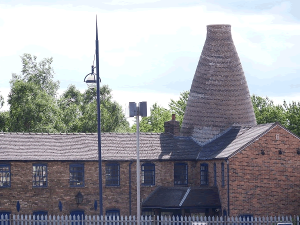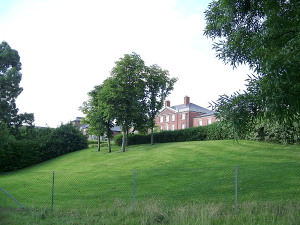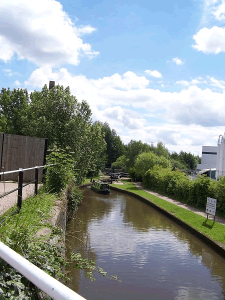’The Potteries’

- Bottle-shaped kilns
- [click on the picture to enlarge it]
The ’Potteries’
The area around Stoke-on-Trent, known as the ’Potteries’, contained several neighbouring towns active in the potteries industry. The manufacturing process took place in the characteristic bottle-shaped kilns, some of which have survived though they are no longer used for this purpose. The area was covered with such kilns.
The area covered by the factories of one of the major industrialists, Josiah Wedgwood, was known as ’Etruria’ after the name of the region in Italy (now Tuscany) where ancient vases were supposed to have originated - they were known as ’Etruscan vases’ (the vases we now consider as ’Greek vases’ made in Southern Italy or Magna Graecia). Wedgwood’s purpose was to produce vases simulating the substance of ancient vases, and this attempt at classical revival was one major spur of his numerous technical experiments, as shown for instance in the Portland Vase (see the website of the Wedgwood Museum).

- Josiah Wedgwood’s House
- [click on the picture to enlarge it]
His house, in the same grounds, was known as ’Etruria Hall’: it was built by the architect Pickford of Derby. The experiments he carried out were of interest to those involved in the development of industry all over Europe, and Etruria Hall is one of the buildings represented on one of the dishes of the dinner set made by Wedgwood for Catherine the Great of Russia (now in the Hermitage Museum in St Petersburg) - other areas represented on plates include the metal manufactures of Coalbrookdale. The dinner set of hundreds of pieces was ordered by Catherine of Russia to have views of rural, industrial and urban Britain, as an example of a modern state to be imitated by other sovereigns. You may find all the pieces by putting ‘Wedgwood’ in the search engine on the Hermitage website.
Wedgwood had successive showrooms in London.
Wedgwood, science and society
Wedgwood was also a member of an active scientific group, the Lunar Society. He campaigned as well with anti-slavery groups, and made a medallion (1787) in which he inverted his usual practice (white figures on a dark background) to show a black man again a light-couloured background, with the motto ‘Am I not a man and a brother ?’

- Trent and Mersey canal
- [click on the picture to enlarge it]
Wedgwood supported plans for the Trent and Mersey canal:
- thanks to it, he imported raw material needed for his kilns:
- he transported his fragile goods from the production area (chosen because of the raw material) to the harbours through which they were exported. The history of industry is thus linked to the development of transport.
The canal passes just behind his estate of Etruria (in the preceding picture, to the left of the photo, at the foot of the hill).

